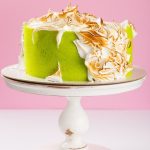Are you wondering how to freeze cakes for decorating? Freezing cakes can be a game-changer when it comes to preparing for special occasions and events. Not only does it save time, but it also eases the decorating process, allowing you to create stunning cake designs with ease. In this article, we will explore the benefits of freezing cakes for decorating, the best types of cakes to freeze, and tips for preparing, freezing, thawing, decorating and storing frozen cakes.
Freezing cakes for decorating is not only a time-saver, but it also allows you to prepare in advance without sacrificing the taste and quality of your cake. Whether you are a professional baker or a home baker looking to elevate your cake decorating skills, learning how to freeze cakes effectively can make all the difference in your baking experience.
When it comes to selecting the right cake to freeze, not all cakes hold up well when frozen. In the next section, we will cover the best types of cakes that are suitable for freezing and provide tips for choosing the right texture and flavor profile to ensure that your cake maintains its deliciousness after being frozen. Stay tuned as we delve into the specifics of choosing the perfect cake for freezing.
Choosing the Right Cake to Freeze
When it comes to freezing cakes for decorating, not all types of cakes hold up well in the freezer. It’s important to choose the right cake texture and flavor that will maintain its quality and taste after being frozen. Here are some tips for choosing the right cake to freeze:
- Best types of cakes: Some cakes that are best for freezing include sturdy and dense cakes such as pound cake, carrot cake, and chocolate cake. These types of cakes have a good structure that can withstand the freezing process without becoming mushy or losing their shape.
- Cake texture and flavor: When selecting a cake to freeze for decorating, consider the texture and flavor that will hold up well. Avoid moist and delicate cakes such as angel food cake or sponge cake, as they may become too soggy or dry out when frozen.
- Tips for selecting the right cake: Look for recipes that use ingredients like sour cream, buttermilk, or oil, which can help retain moisture in the cake during freezing. Additionally, opt for flavors that are known for improving over time, such as fruit-based cakes or rich chocolate flavors.
By choosing the right type of cake to freeze for decorating, you can ensure that your baked creations maintain their delicious taste and texture even after being stored in the freezer. Following these tips will help you select a cake that is perfect for freezing and decorating to create beautiful and tasty treats.
Preparing the Cake for Freezing
Once you have chosen the right type of cake for freezing, it’s important to properly prepare it before placing it in the freezer. The first step is to allow the baked cake layers to completely cool. Placing warm or hot cakes in the freezer can lead to condensation, which can make the cake soggy when thawed.
After cooling, it’s essential to wrap the cake layers tightly and securely to prevent them from drying out or absorbing any unwanted flavors from other foods in the freezer. A great way to do this is by using plastic wrap or aluminum foil. Some bakers also opt for an additional layer of protection by placing the wrapped cake layers in a resealable plastic bag.
To maintain maximum freshness and flavor, it’s recommended to label each wrapped cake layer with the date it was baked before placing it in the freezer. This will help you keep track of how long each cake layer has been frozen and ensure that you use them within their optimal time frame.
| Step | Description |
|---|---|
| Cooling | Allow baked cake layers to cool completely before freezing |
| Wrapping | Wrap cake layers tightly with plastic wrap or aluminum foil, then place them in a resealable plastic bag for extra protection. |
| Labeling | Label each wrapped cake layer with the date before placing in the freezer to keep track of storage time. |
Freezing and Thawing Methods
When it comes to freezing cakes for decorating, there are a few different methods you can use to ensure the best results. Here are some popular freezing and thawing methods to consider:
- Flash Freezing: This method involves placing the freshly baked cake layers in the freezer for a short period of time to firm them up before wrapping them for long-term storage. Flash freezing helps prevent the cake from getting too soft or sticky when wrapped.
- Double Wrapping: To maintain the freshness and flavor of the cake layers, consider double wrapping them in plastic wrap and then aluminum foil. This extra layer of protection helps prevent freezer burn and keeps the cake moist during the freezing process.
- Slow Thawing: When it comes time to thaw your frozen cake layers, it’s important to do so slowly in order to retain their moisture and texture. Place the wrapped cake in the refrigerator overnight or on the counter for a few hours before decorating.
Choosing the right freezing and thawing methods will depend on your specific recipe and decorating timeline. It’s important to consider factors such as moisture retention, flavor preservation, and ease of handling when deciding which method is best for your frozen cakes.
Decorating Tips for Frozen Cakes
Working With Frozen Cakes
When it comes to decorating frozen cakes, it’s important to note that they are easier to work with compared to fresh cakes. The frozen texture makes them more stable and less prone to crumbling, allowing for smoother and cleaner decoration. It also allows for better precision when adding intricate details or designs to the cake.
One key tip when decorating a frozen cake is to work quickly but carefully. The cold temperature of the cake will cause the frosting to set faster, so be mindful of your time as you apply the frosting and decorations. Additionally, if you need to make adjustments or corrections, doing so while the frosting is still pliable is recommended.
Achieving Smooth Frosting
To achieve smooth and clean frosting on a frozen cake, start by applying a thin layer of frosting as a crumb coat. This initial layer will help seal in any crumbs and create a smooth surface for the final layer of frosting. Once the crumb coat has set, you can then apply a thicker layer of frosting for your desired design or finish.
It’s also important to use an offset spatula or a bench scraper to help create an even layer of frosting on the cake’s surface. The cold temperature of the frozen cake will further assist in keeping the frosting firm and in place as you work on achieving that perfect finish.
Adding Decorations
When it comes to adding decorations such as fondant embellishments or piping details onto a frozen cake, keep in mind that these elements will adhere more easily due to the firmness of the cake. This makes it easier to handle intricate decorations without causing any smudges or smears on the cake’s surface.
Additionally, if you are planning to add edible prints or images onto your frozen cake, they will hold up well and maintain their shape during application. This not only saves time but also reduces the risk of tearing or distorting delicate designs while handling them on a fresh cake.
By following these tips for working with frozen cakes during decorating, you can ensure a more efficient and less stressful experience while achieving professional-looking results.
Storing Decorated Cakes
After you have spent time and effort decorating your cake, it’s essential to take the necessary steps to store it properly. Storing a decorated cake properly will ensure that it stays fresh, moist, and flavorful until it’s ready to be served.
One method for storing decorated cakes is to place them in a cake box or airtight container and then put them in the refrigerator. The cool temperature will help keep the cake fresh and prevent the frosting from melting or losing its shape. It’s important to let the cake come to room temperature before serving it, as this will allow the flavors to fully develop.
Another option for storing decorated cakes is to freeze them. Once the cake is fully decorated, place it in a freezer-safe container or wrap it securely with plastic wrap and then aluminum foil before placing it in the freezer.
When you’re ready to serve the cake, simply remove it from the freezer and let it thaw in the refrigerator overnight. This method works well for preserving the cake if you need to make it in advance of an event.
To maintain the freshness of your decorated cakes, avoid placing them in direct sunlight or near any sources of heat. Extreme temperatures can cause the frosting to melt or become discolored, so be sure to store your cakes in a cool, dry place until they are ready to be enjoyed.
| Storage Method | Instructions |
|---|---|
| Refrigeration | Place in a cake box or airtight container and refrigerate; let come to room temperature before serving |
| Freezing | Wrap securely with plastic wrap and aluminum foil before freezing; thaw in refrigerator overnight when ready to serve |
| Avoiding Heat/Light | Avoid direct sunlight or sources of heat which can affect frosting consistency |
Common Mistakes to Avoid
When it comes to freezing and decorating cakes, there are some common mistakes that can easily be made if not careful. One of the most common mistakes is not allowing the cake to cool completely before freezing. It’s important to make sure that the cake is completely cooled to room temperature before wrapping and freezing it, as any residual warmth can create condensation in the wrapping, leading to a soggy cake once thawed.
Another mistake to avoid when freezing cakes for decorating is not properly wrapping and sealing the cake layers. Failing to wrap the cakes tightly or using inadequate materials can lead to freezer burn and loss of moisture, resulting in a dry and unpleasant texture once the cake is thawed. It’s important to use plastic wrap or aluminum foil to tightly cover each layer of the cake before placing it in the freezer.
Additionally, a common mistake when decorating frozen cakes is trying to rush the process. Decorating a frozen cake requires patience and attention to detail, as rushing through the process can result in cracked or uneven frosting. It’s important to allow the cake sufficient time to thaw before applying any decorations or frosting, and to work carefully and methodically to achieve a professional-looking result.
By being aware of these common mistakes and taking steps to avoid them, you can ensure a successful experience when freezing and decorating cakes. Paying attention to proper cooling, wrapping, and thawing techniques will help preserve the quality and flavor of your cakes, while allowing for smooth and beautiful decorating results.
Conclusion
In conclusion, freezing cakes for decorating can be a game changer for those who love to bake and decorate. Not only does it save time and make the decorating process easier, but it also allows for more flexibility in terms of when you can bake and decorate the cake.
By choosing the right type of cake, preparing it properly for freezing, and using the correct freezing and thawing methods, you can ensure that your cakes turn out just as delicious and beautiful as if they were freshly baked.
In addition to the benefits of freezing cakes for decorating, it’s important to remember some final tips and advice for a successful experience. First, always make sure to let your cake layers cool completely before wrapping and freezing them to prevent condensation.
Additionally, when it comes to decorating frozen cakes, be patient and work quickly to achieve smooth frosting and clean decorations. Lastly, when storing decorated cakes after freezing and decorating, use airtight containers or wrap them tightly in plastic wrap to maintain their freshness.
Overall, by following the guidelines provided in this article and avoiding common mistakes when freezing and decorating cakes, you can achieve professional-looking results with ease. Freezing cakes for decorating is not only a time-saver but also a method that allows you to have delicious homemade cakes ready for any occasion.
So next time you’re planning to bake a cake for an event or celebration, consider utilizing the tips outlined in this article for a stress-free baking and decorating experience.
Frequently Asked Questions
How Do You Freeze Cake to Decorate Later?
Freezing cake to decorate later can be done by first allowing the cake to cool completely after baking. Once cooled, wrap the cake tightly in plastic wrap to prevent freezer burn and then place it in a freezer-safe container or a heavy-duty freezer bag.
Be sure to label the container with the date and type of cake. When you’re ready to decorate, remove the cake from the freezer and allow it to defrost in the refrigerator overnight before adding frosting or decorations.
Is It OK to Freeze Cake Before Frosting?
Yes, it is perfectly okay to freeze a cake before frosting it. In fact, freezing the cake layers can make them easier to handle and less likely to crumble when you’re adding frosting or other decorations.
Just be sure to let the cake layers cool completely after baking before wrapping them in plastic wrap and placing them in the freezer. When you’re ready to frost the cake, simply remove the layers from the freezer and allow them to defrost in the refrigerator overnight.
How Do You Freeze a Cake and Keep It Moist?
To freeze a cake and keep it moist, start by ensuring that the cake is fully cooled after baking. Then, wrap it tightly in several layers of plastic wrap to seal out air and moisture. Next, place the wrapped cake in a freezer-safe container or heavy-duty freezer bag, removing as much air as possible before sealing it shut.
Properly frozen and sealed cakes can last for several months without losing moisture or flavor. When it’s time to defrost and serve the cake, simply let it thaw at room temperature inside its wrapping until fully thawed.

Welcome to my blog about home and family. This blog is a place where I will share my thoughts, ideas, and experiences related to these important topics. I am a stay-at-home mom with two young children. I hope you enjoy reading it! and may find some helpful tips and ideas that will make your home and family life even better!





